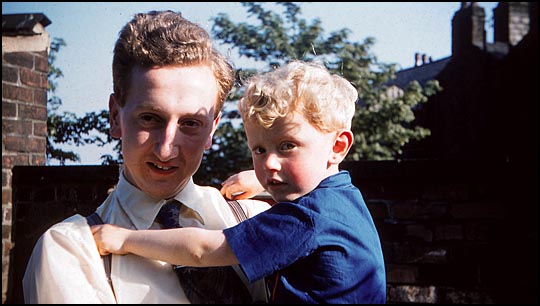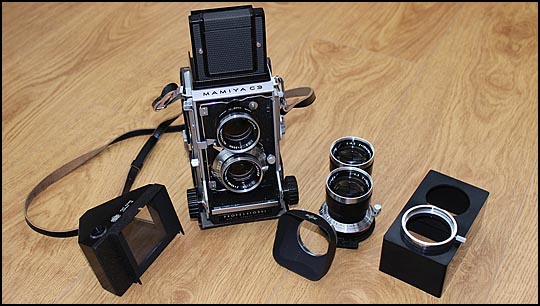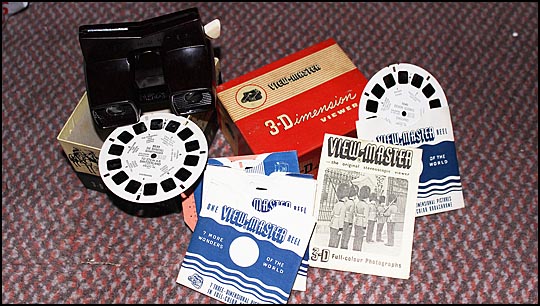In March this year we lost my Uncle Geoff. At 83 he had been a lifelong bachelor and my brother and I found ourselves next of kin. He was a bit of a collector was my Uncle Geoff. He had a few collections but perhaps the one going back the farthest was photography-related.

There was a collection of cameras, accessories, studio lighting and darkroom equipment to make most photographers go "Film? Chemicals? Spending hours in pitch black or dingy red light messing about trying to get films and prints to develop?"
Er, yes... photography was not the unthinking push-button, sort-it-out-in-PhotoShop, freebie that we tend to think of today. There were albums and albums of photos that pre-dated Uncle Geoff himself and I've featured already just a tiny portion of them. More will come. Here though I'm going to concentrate on Uncle Geoff's own photos.

We've had a look at some of his photos from the 1940s and 50s before. Taken on a Kodak Bantam camera (which was sadly missing from the collection) that took 828 format film (long gone!) these were the snapshots of his early teens.

This one shows my Dad with one of their model aeroplanes (another passion!) up on the moors above Rochdale where they lived. This was a free-flight machine with a glow-plug engine. It is wired to a battery which is warming up the spark plug (hence "glow plug") and this engine will take the plane up to a height of a hundred or couple of hundred or so feet and then power the aircraft away from them in an uncontrollable direction dictated by wind and up-drafts or down-drafts. After a couple of minutes the engine will run out of fuel and the plane will then glide, sometimes for miles, eventually coming to rest in someone's garden, in the middle of the road, or against the back of someone's head...
It would most certainly not be allowed now! They did have insurance just in case. Finding it when it landed was a matter of getting on a bicycle and chasing it and hoping it didn't fly across reservoirs and fields too much. If it disappeared they put an advert in the local paper offering a reward of ten shillings (50p - a considerable sum in the 1940s/50s for two teenagers).

We thought that these models would have been thrown away many years ago but no... Even the one in the black and white photo still exists, along with some quite collectable engines. Uncle Geoff had obviously spent a bit of time still experimenting with such modern whimsies as radio-control. But this is an aside - back to the photography!

This is me and my Dad. I'd never seen this photo before. Here's one of the strange quirks really. There were literally thousands of photos I hadn't seen before. This must be around 1956 and colour film was not that common back then and certainly would not have been cheap. I've found ancestors I had never seen photos of before. I've found photos of ancestors whose names I don't know...

I've found photos of events that either don't exist any more or are rare. This is my Grandma, Annie Burke, on the far left, leading the parade at a Church Parade. There were Church Parades and then once a year there would be the Whit Walks, where churches and organisations would dress up floats on the backs of lorries and people in fancy dress would stand on the flat backs of the moving lorries with no safety harness or even anything to grab hold of - except a pal... "I'm falling...! No... We're falling...!".
I remember a field somewhere in Rochdale that was called the Good Friday Field because after church parades on that day the majority of Rochdale's population went to sit on it, playing games like tag or football with either a ball or a tin can or cowboys and indians with cap guns that even with the caps (which contained tiny amounts of explosive) failed to sound anything like guns on the TV cowboy shows.

Some of Uncle Geoff's cameras were expensive semi-professional ones. This collection had cost him a fortune in the 1980s and if I've found four films from it, that's about it.

Here's another one. Mamiya cameras were a staple of wedding photographers along with Rolleicords which were similarly a twin lens reflex camera. You looked through the top lens and the photo was taken through the bottom one. This did mean that the photo wasn't exactly what you were seeing but most photographers soon got used to that and compensated for it by framing the subject slight high. Added to this was the problem that what you saw was a mirrored image. Not too much of a problem for weddings admittedly, but if you were a journalist taking photos of moving subjects then it was quite tricky to follow a racing car moving left to right when your camera showed it moving right to left...
Even with the cameras requiring film rather than an SD card they were fairly easy to sell - if not quite for the original value!

These early cameras required a separate piece of equipment to measure the brightness of the light and then you had to set both shutter speed and the aperture size manually on the camera. This is a Weston Master V, one of the most sought-after bits of kit of its day. There's something quite neat about pointing it in different directions and seeing the needle move as you move from shadow to highlight.

Flashguns never came attached to cameras either until much later. These are 1970s or 1980s flashguns. Rather large cases to hold something which now pops up on a camera or sits in a little window on the front.

But even they were a vast improvement on the glass flashbulbs that preceded them. These little dealers of burns and occasional explosion of glass fragments are filled with fine magnesium filament. The blue colour balances the light for daylight film. The huge reflector dish means that light going off to the side is reflected back at the subject and the bulbs are single-use only. Once you take the photo, the magnesium is set alight by a discharge from the battery in the flash holder and burns extremely quickly and hot enough to melt the glass of the bulb which will actually bubble so that once used the shape of the bulb will have changed. Handling them before they had cooled was painful!

And all that was just to take a photo! You couldn't look at it in the camera. You couldn't just take out the film and "plug it in" to anything to look at the pictures. The film had to be developed which was either a very tricky procedure involving some pretty nasty chemicals that had to be exactly the right temperature for the length of the process or you sent the film away or took it to the local chemist to be developed. The film had to be handled in total pitch dark. When I say "chemist" I mean that there were no photo shops who specialised in just developing and printing your photos. The closest would be those camera shops run by an enthusiast who had their own darkroom. My Great-Uncle Percy was one of those. Uncle Geoff had his own darkroom at home.

He had a lot of darkroom equipment. I'm not sure he ever used it all, but he had a lot... I used to process both black and white (dead easy but required a lot of time) and colour slides (very tricky requiring you to fill the bath with very hot water in order to keep the temperature in a black processing tank steady. A quarter of a degree centigrade sent the colour towards either blue or yellow depending whether the temperature went up or down. Once processing was complete (and you couldn't see the colour until it was complete) there was no way to correct a colour cast. I even did colour prints (very very hard, source of intense frustration, didn't do it often!)

I even found this, which I suspect had perhaps belonged to my grandparents - the house was large, had a cellar and a full attic and nothing had been thrown away since the ashes of the last open fire...
The house is now empty, but there are many more fascinating things to look at over a few articles yet!
No comments:
Post a Comment
All comments must be passed by moderator before appearing on this post.